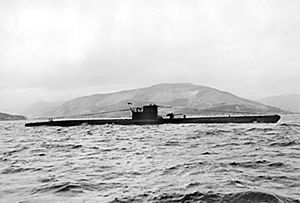German submarine U-975 facts for kids
class="infobox " style="float: right; clear: right; width: 315px; border-spacing: 2px; text-align: left; font-size: 90%;"
| colspan="2" style="text-align: center; font-size: 90%; line-height: 1.5em;" | 
|} The German submarine U-975was a Type VIIC U-boatused by Nazi Germany's navy, the Kriegsmarine, during World War II. U-boats were submarines that played a big role in naval battles. U-975was ordered on June 5, 1941. Its construction began on July 10, 1942, at the Blohm & Voss shipyard in Hamburg. The submarine was officially launched on March 24, 1943. It was then put into service on April 29, 1943, under the command of Hans-Joachim Ebersbach.
Contents
| History | |
|---|---|
| Name | U-975 |
| Ordered | 5 June 1941 |
| Builder | Blohm & Voss, Hamburg |
| Yard number | 175 |
| Laid down | 10 July 1942 |
| Launched | 24 March 1943 |
| Commissioned | 29 April 1943 |
| Fate | Surrendered on 9 May 1945; sunk as part of Operation Deadlight on 10 February 1946 |
| General characteristics | |
| Class and type | Type VIIC submarine |
| Displacement |
|
| Length |
|
| Beam |
|
| Height | 9.60 m (31 ft 6 in) |
| Draught | 4.74 m (15 ft 7 in) |
| Installed power |
|
| Propulsion |
|
| Speed |
|
| Range | |
| Test depth |
|
| Complement | 4 officers, 44–52 enlisted |
| Armament |
|
| Service record | |
| Part of: |
|
| Commanders: |
|
| Operations: |
|
| Victories: | None |
What Was a Type VIIC U-boat?
The U-975 belonged to the Type VIIC class of submarines. These were some of the most common U-boats used by Germany during World War II. They were known for being strong and versatile.
How Big Was U-975?
When U-975 was on the surface, it weighed about 769 tons. When it was underwater, it weighed more, around 871 tons. The submarine was about 67.10 meters (220 feet) long overall. Its main body, called the pressure hull, was about 50.50 meters (165 feet) long.
The submarine was 6.20 meters (20 feet) wide and 9.60 meters (31 feet) tall. It sat 4.74 meters (15 feet) deep in the water.
How Did It Move?
U-975 used two different types of engines to move.
- When on the surface, it used two powerful diesel engines. These engines gave it a top speed of 17.7 knots (about 32.8 kilometers per hour or 20.4 miles per hour).
- When underwater, it switched to two electric motors. These motors allowed it to travel at a top speed of 7.6 knots (about 14.1 kilometers per hour or 8.7 miles per hour).
The submarine could travel about 8,500 nautical miles (15,742 kilometers) on the surface at a slower speed. Underwater, it could go about 80 nautical miles (148 kilometers) before needing to surface.
How Deep Could It Go?
U-975 was designed to operate safely at depths of up to 220 meters (720 feet). Its maximum safe depth was around 250 to 295 meters (820 to 968 feet). Going deeper than this could cause the submarine to be crushed by the immense water pressure.
What Weapons Did It Carry?
U-975 was armed with several weapons:
- Torpedoes: It had five torpedo tubes, four at the front and one at the back. It could carry 14 torpedoes.
- Mines: Instead of torpedoes, it could carry 26 naval mines.
- Deck Gun: It had one 8.8 cm (3.5 inch) deck gun with 220 rounds of ammunition. This gun was used when the submarine was on the surface.
- Anti-Aircraft Gun: It also had one twin 2 cm (0.79 inch) anti-aircraft gun to defend against planes.
The submarine usually had a crew of 44 to 52 sailors.
U-975's Service and End
U-975 was part of several U-boat flotillas during its service. These were groups of submarines that worked together. It had five different commanders during its time in the war. The submarine completed only one patrol, which took place in several short stages in June and July 1944. It did not sink any enemy ships during its operations.
On May 9, 1945, at the end of World War II, U-975 surrendered to the Allied forces in Horten, Norway. It was then moved to Lisahally, Northern Ireland, on May 27, 1945.
Operation Deadlight
After the war, many German U-boats that had surrendered were sunk by the Allied forces. This operation was called Operation Deadlight. U-975 was one of 116 U-boats chosen to be sunk.
On February 10, 1946, U-975 was towed out to sea. It was then sunk by the British frigate HMS Loch Arkaig. The wreck of U-975 now lies at coordinates 55°42′N 09°01′W / 55.700°N 9.017°W.

